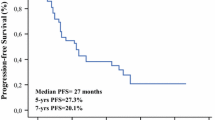Summary
One possible explanation for the failure of the high concentrations of cytotoxic agents achieved following intraperitoneal (i.p.) drug delivery to produce a favorable response in patients with ovarian cancer is the inability of the drug-containing fluid to be adequately distributed throughout the peritoneal cavity, usually because of intraabdominal adhesion formation. To evaluate the influence of the severity of adhesions, observed at the time of laparotomy performed immediately preceding the initiation of i.p. therapy, on the ability to achieve a surgically defined complete response (S-CR), we retrospectively reviewed the operative reports of 70 patients with small-volume residual ovarian cancer treated on one of three phase-2 salvage i.p. trials at the Memorial Sloan-Kettering Cancer Center. The S-CR rate in the 36 patients withlimited adhesion formation observed upon entering the peritoneal cavity was 28%, compared to 35% in the 34 patients withextensive adhesions (P>0.05). In 33 patients treated with a phase-2 cisplatin-based i.p. program, who had previously responded to systemic platinum, 47% (8/17) and 44% (7/16) of those with limited and extensive adhesions, respectively, achieved a S-CR (P>0.05). We conclude that the presence of extensive adhesions observed within the peritoneal cavity at the time of a laparotomy performed immediately prior to the initiation of i.p. therapy does not have a negative impact on the potential to achieve an S-CR, assuming it is technically feasible to lyse all significant adhesions prior to the completion of the operative procedure.
Similar content being viewed by others
References
Dunnick NR, Jones RB, Doppmen JL, Speyer J, Myers CE (1979) Intraperitoneal contrast infusion for assessment of intraperitoneal fluid dynamics. AJR 133:221–223
Howell SB, Pfeifle CE, Wung CE, Olshen RA, Lucas WE, Yon JL, Green M (1982) Intraperitoneal cisplatin with systemic thiosulfate protection. Ann Intern Med 97:845–851
Levenback C, Curtin J, Rubin S, Yeh S, Hoskins W, Chapman D, Jones W, Hakes T, Markman M, Reichman B, Lewis JL Jr (1989) A longitudinal study of the distribution of intraperitoneally administered fluids as determined by radionuclide scanning (abstract). In: Proceedings of the International Gynecological Cancer Society, vol 2, P 161
Markman M (1986) Intraperitoneal anti-neoplastic agents for tumors principally confined to the peritoneal cavity. Cancer Treat Rev 13:219–242
Markman M (1991) Intraperitoneal chemotherapy. Semin Oncol 18:248–254
Markman M, George M, Hakes T, Reichman B, Hoskins W, Rubin S, Jones W, Almadrones L, Lewis JL Jr (1990) Phase II trial of intraperitoneal mitoxantrone in the management of refractory ovarian cancer. J Clin Oncol 8:146–150
Markman M, Hakes T, Reichman B, Hoskins W, Rubin S, Jones W, Almadrones L, Yordan EL Jr, Eriksson J, Lewis JL Jr (1991 a) Intraperitoneal cisplatin and cytarabine in the treatment of refractory or rcurrent ovarian carcinoma. J Clin Oncol 9:204–210
Markman M, Reichman B, Hakes T, Jones W, Lewis JL Jr, Rubin S, Almadrones L, Hoskins W (1991 b) Responses to second-line cisplatin-based intraperitoneal therapy in ovarian cancer: influence of a prior response to systemic cisplatin. J Clin Oncol (in press)
Reichman B, Markman M, Hakes T, Hoskins W, Rubin S, Jones W, Almadrones L, Ochoa M Jr, Chapman D, Saigo P, Lewis JL Jr (1989) Intraperitoneal cisplatin and etoposide in the treatment of refractory/recurrent ovarian carcinoma. J Clin Oncol 7:1327–1332
Rosenshein N, Blake D, McIntyre PA, Parmley T, Natarajan TK, Dvornicky J, Nickoloff E (1978) The effect of volume on the distribution of substances instilled into the peritoneal cavity. Gynecol Oncol 6:106–110
Author information
Authors and Affiliations
Additional information
Supported in part by the Avon Program in Ovarian Cancer, Memorial Sloan-Kettering Cancer Center
Rights and permissions
About this article
Cite this article
Markman, M., Jones, W., Lewis, J.L. et al. Impact of laparotomy finding of significant intraabdominal adhesions on the surgically defined complete response rate to subsequent salvage intraperitoneal chemotherapy. J Cancer Res Clin Oncol 118, 163–165 (1992). https://doi.org/10.1007/BF01187507
Received:
Accepted:
Issue Date:
DOI: https://doi.org/10.1007/BF01187507




